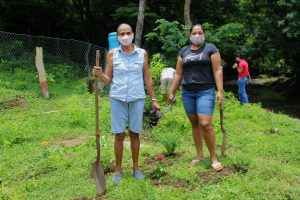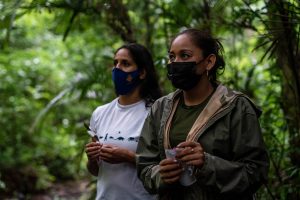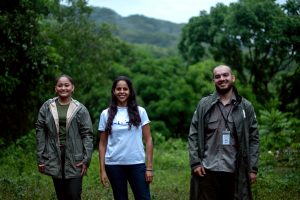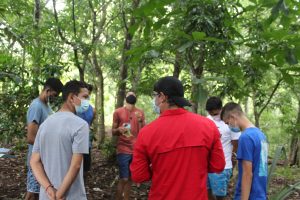A biological corridor in the dry tropics
In Costa Rica’s Northern Pacific Dry Tropical Forest, between the Potrero, Caimital, and Quirimán river basins, lies the Potrero Caimital Biological Corridor. It is home to thousands of species and is essential in preserving environmental and water resources in Hojancha, Nicoya, and Santa Cruz counties.

Reforestation campaign.
According to the country’s Biodiversity Law, biological corridors are defined territories that connect protected wilderness areas, landscapes, ecosystems, and habitats. These spaces can be natural or modified, in rural or urban places, and help maintain biodiversity and ecological and evolutionary processes. When surrounding communities get involved, biological corridors promote environmental awareness and synergy between local residents and nature.
Since 2006, the Nicoyagua Foundation, the National System of Conservation Areas (SINAC), and entities like CoopeGuanacaste have promoted the creation and maintenance of the corridor. They are joined by leaders and activists who have put their knowledge, energy, and heart into a project that lovingly cares for the water sources that supply entire communities. A few years ago, our University joined these efforts through EARTH Futures, the global solutions center.

Dunia Martínez and Karina Poveda.
Dunia Martínez is a member of the local corridor committee and a specialist in environmental education, community development, and aquifer mapping. She has worked for more than six years with the Nicoyagua Foundation and SINAC to identify natural springs, integrate farmers and producers into the project, and conserve and manage water resources. For her, EARTH’s participation in the project’s coordination has been essential to solidify actions and streamline each stage.

Dunia, Karina and Mario Quesada from SINAC, of the local committee.
“With the help of Karina Poveda (’14, Costa Rica) from EARTH Futures, we were able to create the local corridor committee. We were also able to establish a management plan. SINAC requires all biological corridors to have one to determine their focal points for management. We also have worked on different activities, like trash pickups, deep cleaning of the rivers, reforestation, and covering the springs. An important element is that we have created a positioning strategy for the corridor for people to identify with it via an image and logo,” says Dunia.
Thanks to the CRUSA Foundation’s assistance, EARTH Futures strengthened the biological corridor’s management strategy, helped create local alliances, led environmental awareness strategies, and provided technical support to build a countywide policy on climate change mitigation and adaptation.

One of the workshops.
However, the most tremendous success has come from committed people like Dunia, who have actively integrated into the project and encouraged others to join. For example, when they do river cleanups, they also give environmental education talks about protecting biodiversity and water. This connects activity with critical thinking to make these actions part of everyday life in the community.
Environmental education and community integration have been key to the Potrero Caimital Biological Corridor’s success — a “green lung” and life-giving water source that interconnects communities and nature.




